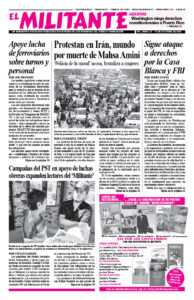In a victory for South Carolina death row prisoners and opponents of the death penalty, Richmond County Court Judge Joselyn Newman issued an injunction Sept. 6 that bars the state from executing inmates by firing squad or the electric chair. Since 1985 seven prisoners in the state have been electrocuted.
The ruling came in a case brought by Freddie Owens, Brad Sigmon, Gary Terry and Richard Moore, four of the 34 prisoners on South Carolina’s death row. The judge agreed with the prisoners, who said these methods of execution violate the South Carolina state constitution’s prohibition against “cruel, unusual and corporal punishments.”
After a series of botched and torturous executions using lethal injections were widely publicized, 25 pharmaceutical companies stopped selling the chemicals used in most of them. Prison officials across the country, including in South Carolina, have been maneuvering to institute alternative methods. The state government then adopted new protocols that would force prisoners, 14 days before their execution, to “choose” between the 109-year-old electric chair or being shot to death.
Newman ruled that South Carolina’s use of electrocution as its default method of execution “ignored advances in scientific research and evolving standards of humanity and decency.” She noted that in the past 50 years only Utah has used a firing squad.
The trial included graphic testimony from doctors, professors and others describing the barbarity of these types of executions. In South Carolina, the state’s new electrocution protocol said a copper electrode is attached to the prisoner’s right leg, and another to his head using a copper hat. A conductive solution-soaked sponge is placed between the scalp and head electrode. An electric current of 2,000 volts is sent coursing through the prisoner’s body for 4.5 seconds, followed by 1,000 volts for 8 seconds, then 120 volts for two minutes.
After reviewing electrocution autopsy reports, Dr. Jonathan Arden, a pathologist for the state of West Virginia, testified that the resulting “severe electrical and thermal burns” would be “the equivalent of cooking.” He said that the prisoners would feel “horrific pain” if at all conscious, and the muscles around the chest and lungs would “tetanize,” meaning the prisoner couldn’t breathe.
As for execution by firing squad, the protocol calls for the inmate to be strapped to a backless metal chair with a hood over the head. Sharpshooters 15-feet away take aim with rifles at a target pinned over the prisoner’s heart. If the prisoner isn’t dead after 10 minutes, another volley is fired, then a third if the prisoner is still alive.
Dr. Arden testified that an inmate won’t immediately lose consciousness when shot in the heart, because sufficient oxygen remains for the brain to continue feeling and thinking. The “fractures of the ribs and sternum would cause excruciating pain,” especially “when making any movements such as flinching or breathing.”
A spokesman for South Carolina Gov. Henry McMaster said the state would appeal the ruling.
South Carolina is one of 27 states where the death penalty remains legal. That number has been falling for years, as public opinion against the death penalty has grown.

